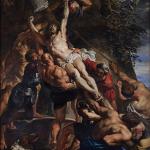Charon Ross offers a brilliant analysis of rock concerts as ecstatic experiences (Gifts Glittering and Poisoned, 132-4). The concert is a carefully orchestrated symbolic constellation “designed to enable the spectator to have experiences of ecstasy so wonderful and powerful that they are difficult to capture with words. Euphoria washes in waves over the enormous crowds, and with raised hands the spectators wave, yell, and scream lyrics that most of them know by heart. This ecstasy is facilitated by a great sense of belonging and mutuality that comes from participating as a member of the enormous crowd of spectators. This belonging coincides with a complete absence of personal space. Bodies are crammed together so closely that everyone is touching someone else, and an overt sexual tension permeates the air.”
The performers are projected and lighted to make them “appear larger than life and superhuman.” Yet these transcendent figures condescend to allow people from the crowd to join them on the stage. In a “quasi-incarnational” moment during a U2 concert, “Bono, the lead singer, selected a female fan and lay down with her on stage. After cuddling her for several minutes, and finally kissing her on the mouth, he returned her to the crowd.” It was an ecstatic moment for the young woman; but it also “left many of the other spectators longing to have the same experience with their idol.”
Ross draws a conclusion about those Gen Xs and other young people you’ve heard about: They “may be absent from the church’s pews, but this is not because young people have been secularized. Rather, they exhibit a deep and profound longing for transcendence, ecstatic experience, mutuality, and even incarnational metaphysics.” If they’re leaving church, it’s because – to coin a phrase – they haven’t found what they’re looking for.















